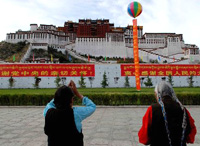
In July the number of visitors to Tibet was up 50 percent from the same period in 2005 reaching 391,000, said Qiangba Puncog, chairman of the Tibet Autonomous Region, in Lhasa on Monday.
Some 374,000 Chinese and 16,700 foreigners visited the region last month and generated 4.35 million yuan (US$545,537) of revenue, which is up 43.7 percent on 2005. Qiangba Puncog made his remarks at a press conference during the Qinghai-Tibet railway news coverage campaign launched by the State Council Information Office.
In 2004, the number of travelers to Tibet reached 1 million for the first time and last year over 1.8 million tourists arrived and brought revenues of nearly 2 billion yuan (US$250 million).
Tibet recently saw a daily flow of nearly 4,000 train travelers via the three lines from Beijing, Chengdu (Chongqing) and Xining (Lanzhou). And there'll be more tourists visiting for a close look of the Potala Palace, said the regional chairman.
But it's a fragile wood-based building which is currently being repaired. To better protect the world cultural heritage site, tickets supply is restricted with 1,600 available for groups and 700 for individuals each day. According to Qiangba Puncog, tourists who aren't able to visit the Potala Palace itself may enjoy its substitution in the future -- the Xuecun Village.
The entire village at the foot of the palace is planned to be moved to make room for a center exhibiting cultural relics from the Potala Palace. Once built, the center will give visitors a chance to get to know about the palace through cultural relics, photos and videos instead of visiting the palace, thus better protecting this cultural heritage, said Qiangba Puncog.
"The traditional Tibetan culture has been fast developed recently," he said. "The opening out of the area could showcase the glamour of the Tibetan culture to the outside world rather than drowning in the so-called 'cultural invasion'," he noted.
In addition to tourism, Tibet is also tapping the potential of inland market, according to Qiangba Puncog. Because of cheaper railway transportation costs (0.12 yuan per ton compared with 0.5 yuan by road), the cost of freight transport is down by 80 percent. This means that such local brand names as Lhasa Beer and the '5100' table-water -- mineral water from the Damxung area which sits at an altitude of 5,100m -- could go to the market far away from Tibet.
But Qiangba Puncog said that the regional government will not use the railway to allow for excessive mineral excavation. Minerals like Lithium would be retrieved properly but alluvial gold prospecting would be strictly forbidden.
The 1,956-km-long Qinghai-Tibet Railway, which went into operation on July 1, links Xining, capital of northwest China's Qinghai Province and Lhasa, regional capital of Tibet. It's the first railway to connect Tibet with other parts of China.
(China.org.cn by staff reporter Li Xiao, August 8, 2006)
|

